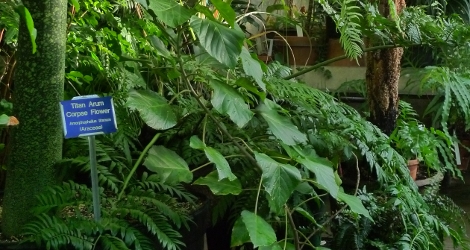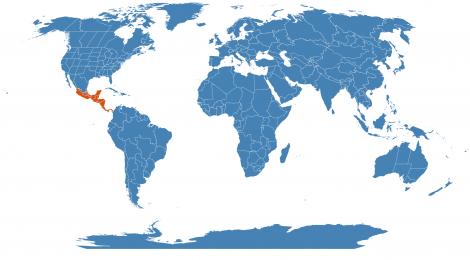Accession Data:
Pouteria campechiana (Kunth) Baehni
- Common Name: Canistel, Egg Fruit
- Family: Sapotaceae Juss.
- Uses: Canistels are rich in niacin and carotene (provitamin A) and have a fair level of ascorbic acid.1
A decoction of the astringent bark is taken as a febrifuge in Mexico and applied on skin eruptions in Cuba. A preparation of the seeds has been employed as a remedy for ulcers.1
- IMPORTANT NOTE: Plant Uses are for informational purposes only. EEB Greenhouses assume no responsibility for adverse effects from the use of any plants referred to on this site. Always seek advice from a professional before using any plant medicinally.
- Culture: tropical or sub-tropical conditions required. Moderate moisture, can survive in areas with long dry season.
- USDA Zone: 10a-11
Accession Data:
- Accession # 200300322
- Source: Debbie Black - UIUC
- Accession Date: 10-09-2003
- Bench: 1304 - NEOA: North Bench W
- Currently: active - healthy
- Qty: 1 confirmed on 10-08-2024
Classification:
- Division: Magnoliophyta
- Class: Magnoliopsida
- SubClass: asterids
- Order: Ericales
- SubOrder:
- Family: Sapotaceae
- SubFamily: Chrysophylloideae
- Tribe:
- SubTribe:
Flowering Data:
This accession has been observed in bloom on:| Year | Jan | Feb | Mar | Apr | May | Jun | Jul | Aug | Sep | Oct | Nov | Dec | ||||||||||||||||||||||||||||||||||||||||
|---|---|---|---|---|---|---|---|---|---|---|---|---|---|---|---|---|---|---|---|---|---|---|---|---|---|---|---|---|---|---|---|---|---|---|---|---|---|---|---|---|---|---|---|---|---|---|---|---|---|---|---|---|
| 2024 | ||||||||||||||||||||||||||||||||||||||||||||||||||||
| 2023 | ||||||||||||||||||||||||||||||||||||||||||||||||||||
| 2022 | ||||||||||||||||||||||||||||||||||||||||||||||||||||
| 2021 | ||||||||||||||||||||||||||||||||||||||||||||||||||||
| 2020 | ||||||||||||||||||||||||||||||||||||||||||||||||||||
| 2019 | ||||||||||||||||||||||||||||||||||||||||||||||||||||
| 2018 | ||||||||||||||||||||||||||||||||||||||||||||||||||||
| 2017 | ||||||||||||||||||||||||||||||||||||||||||||||||||||
| 2016 | ||||||||||||||||||||||||||||||||||||||||||||||||||||
| 2015 | ||||||||||||||||||||||||||||||||||||||||||||||||||||
| 2014 | ||||||||||||||||||||||||||||||||||||||||||||||||||||
| 2013 | ||||||||||||||||||||||||||||||||||||||||||||||||||||
| 2012 | ||||||||||||||||||||||||||||||||||||||||||||||||||||
| 2011 | ||||||||||||||||||||||||||||||||||||||||||||||||||||
| 2010 | ||||||||||||||||||||||||||||||||||||||||||||||||||||
| 2009 | ||||||||||||||||||||||||||||||||||||||||||||||||||||
| 2008 | ||||||||||||||||||||||||||||||||||||||||||||||||||||
References (internal):
- EEB Greenhouse Holdings native to: Mexico Central / Mexico Gulf / Mexico Southwest / Mexico Southeast / Belize / Costa Rica / El Salvador / Guatemala / Honduras / Nicaragua / Panama /
References (external):
- Morton, J. 1987. Canistel. p. 402-405. In: Fruits of warm climates. Julia F. Morton, Miami, FL.
- The Plant List (2010). Version 1. Published on the Internet; http://www.theplantlist.org/ (accessed 4 November 2013).
- WCSP (2013). 'World Checklist of Selected Plant Families'. Facilitated by the Royal Botanic Gardens, Kew. Retrieved 4 November 2013.
- Pouteria campechiana. (2012, December 24). Wikispecies, . Retrieved 13:17, November 4, 2013
- The Global Biodiversity Information Facility: GBIF Backbone Taxonomy, 2013-07-01. Accessed on 2013-11-04
data regenerated on Tue, 08 Oct 2024 12:59:06 -0400 [bcm v4.0]
Images:

Additional images for this accession:
Click on thumbnails to enlargeCurrent Accessions in the Sapotaceae
Subfamily Chrysophylloideae
Subfamily Sapotoideae
Tribe Sapoteae
W/C = Wild Collected
 = indicates flowering in past 14 days
= indicates flowering in past 14 days
 = images available for this accession
= images available for this accession
 = map available for this accession
= map available for this accession
 = accession added within past 90 days
= accession added within past 90 days

